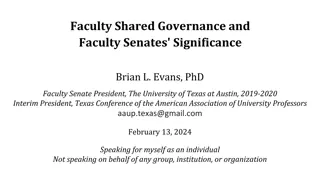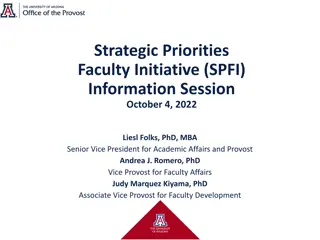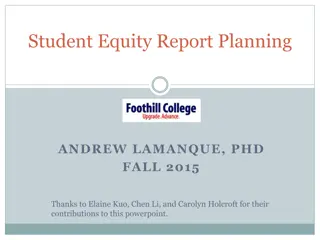
Gender Equity Salary Study Findings at University of Buffalo
Explore the Gender Equity Salary Study at the University of Buffalo, examining historical faculty salary analysis, committee charge, co-chairs, and members of the GESS committee. Discover insights into salary equity among gender groups in academia.
Download Presentation

Please find below an Image/Link to download the presentation.
The content on the website is provided AS IS for your information and personal use only. It may not be sold, licensed, or shared on other websites without obtaining consent from the author. If you encounter any issues during the download, it is possible that the publisher has removed the file from their server.
You are allowed to download the files provided on this website for personal or commercial use, subject to the condition that they are used lawfully. All files are the property of their respective owners.
The content on the website is provided AS IS for your information and personal use only. It may not be sold, licensed, or shared on other websites without obtaining consent from the author.
E N D
Presentation Transcript
OVERVIEW AND SUMMARY FINDINGS OF THE GENDER EQUITY SALARY STUDY - May 2nd, 2018 1
Historical Faculty Salary Equity Analysis at UB The University of Buffalo has continually monitored their internal salary structure for evidence of inequitable treatment, particularly among gender groups of faculty members. - 2009 & 2011 it was persistent in both studies that average received salaries were comparable between male and female faculty members after taking into account work-related factors. 2017 the university again undertook an internal salary equity study to address possible presence of inequities associated with gender. A unique shared-governance approach was adopted in which both faculty and professional staff undertook the study together. Prior studies were undertaken only by professional staff without faculty input. 2 GESS 2018
Committee Charge The Gender Equity Salary Study (GESS) Committee was jointly appointed by the University Provost and the Chair of the Faculty Senate to assess whether there is statistically significant inequity in ladder faculty salaries by gender at the University at Buffalo. - Gender equity in salaries is a reasonable expectation of everyone at the University at Buffalo. Factors that should be considered in order to assess salary equity should be factors that may be expected to impact salary differences. 3 GESS 2018
GESS Committee Co-Chairs Craig Abbey Associate Vice President and Director of Institutional Analysis Glenna Bett Chair of the Faculty Senate Committee on Equity and Inclusion, Associate Professor, Obstetrics and Gynecology, Jacobs School of Medicine and Biomedical Sciences - Peter Elkin Chair of the Faculty Senate Committee on Budget Priorities, Professor and Chair, Biomedical Informatics, Professor of Internal Medicine, Jacobs School of Medicine and Biomedical Sciences Sharon Nolan-Weiss Director, Office of Equity, Diversity and Inclusion, Title IX and ADA Coordinator 4 GESS 2018
GESS Committee Members Sharmista Bagchi-Sen Professor, Geography Rajan Batta, Associate Dean for Faculty Affairs, Human Resources & Diversity, School of Engineering and Applied Sciences - Lucinda Finley Professor, Law Brenda Moore Associate Professor, Sociology Neel Rao Assistant Professor, Economics Gregory Wilding Professor, Chair, Biostatistics 5 GESS 2018
Specific Aims The focus of the internal equity study was twofold: 1. Determine if there is a statistically significant difference in the pay of tenured and tenure-track faculty (ladder) by gender when controlling for academic rank, time in rank, rank at hire and department affiliation. - 2. Determine if there is a statistically significant difference in the pay of tenured and tenure-track faculty (ladder) by gender when controlling for academic rank, time in rank, rank at hire and market factor discipline when comparing the salaries to a national database of academic salaries by discipline. 6 GESS 2018
Statistical Methods A Hierarchical Linear Model and Regression analysis were the statistical procedures used in this study and are most often used by researchers in the field to measure unexplained wage differences for gender. - Regression analysis provides information about the average percent difference in salaries between male and female faculty members and whether this change is significantly different from a zero percent (0%) difference. A 5% significance level was used for this study. This is considered a standard significance level for this type of study. 7 GESS 2018
Statistical Models Model 1 Departmental Salary Comparison This model tests for gender differences in ladder faculty pay conditional on Current academic rank Initial rank Time in rank Department affiliation - Model 2 Discipline Salary Comparison This model tests for gender differences in ladder faculty pay conditional on Current academic rank Initial rank Time in rank Discipline-specific salary market factor 8 GESS 2018
Stakeholder Input It was important to the Committee to provide the UB Community with an opportunity to review the proposed methodology, ask questions, and provide suggestions and feedback. The method was presented to the Faculty Senate Executive committee then the full Faculty Senate where feedback was obtained. - Faculty were invited to attend either of two Town Hall meetings where the GESS study was discussed. October 19th, 2017 was held on South Campus October 23rd, 2017 was held on North Campus Faculty were also invited to provide feedback by email. A Frequently Asked Questions (FAQ) has been created to address commonly asked questions pertaining to UB s Gender Equity Salary Study. 9 GESS 2018
Dataset Study Group Inclusion Criteria All ladder faculty including full professors, associate professors and assistant professors Primary unqualified appointments with FTE of 1.0 State faculty title and annualized base state salary only - Exclusion Criteria Faculty with qualified title (e.g. clinical, research, visiting) All Geographic Full-Time (GFT) faculty All Educational Opportunity Center (EOC) faculty All librarians Tenured faculty serving in an administrative capacity 10 GESS 2018
Data Collection University at Buffalo - Human Resources Data Collection All human resources data was collected from Payroll 17 of the 2016-2017 academic year. - Market Factor Data Collection The 2016-2017 Oklahoma State University Salary Study by Discipline, a national sample of average faculty salaries by discipline, was used to assign corresponding market factors based on discipline and rank. 11 GESS 2018
Faculty Demographics Ethnicity/Race Distributions Gender and Rank Distributions 5 American Indian/Alaskan Native Female Male Total Rank - 238 23 34 Asian 94 165 259 Assistant Black or African American Hispanic 144 214 358 Associate 8 Multiple Races 105 320 425 Professor 734 1042 White 343 699 1042 Total Total 12 GESS 2018
Unadjusted Gender Pay Gap Comparison Gender Pay Gap is the difference in the average man's and average woman's remuneration without accounting for other differences. Group Male $102,331 $81,174 -$21,157 $122,774 $105,144 -$17,630 $133,468 $119,761 -$13,707 $151,809 $139,037 -$12,772 $91,354 $84,997 $103,259 $94,700 $80,858 $73,741 $91,774 $83,283 Female Gap ($) Gap (%) All Public Doctoral University at Buffalo All Public Doctoral University at Buffalo All Public Doctoral University at Buffalo All Public Doctoral University at Buffalo -21% -14% -10% -8% -7% -8% -9% -9% - Overall Full Professors -$6,357 -$8,559 -$7,117 -$8,491 Associate Professors Assistant Professors 13 Source: All Public Doctoral from Academe March/April 2015, UB from human resource data.
Faculty Salary Distribution Male Faculty Female Faculty All Faculty 120 70 180 160 60 100 - 140 50 80 120 40 100 60 80 30 40 60 20 40 20 10 20 0 0 0 40K 60K 80K 320k 100K 120K 140K 160K 180K 200K 220K 240K 260K 280K 300K 40k 60K 80K 100K 120K 140K 160K 180K 200K 220K 240K 260K 280K 300K 320K 40K 60K 80K 100K 120K 140K 160K 180K 200K 220K 240K 260K 280K 300K 320K 14
Faculty Salaries Before Regression Analysis 25th Percentile, Median, 75th Percentile Assistant Professor Associate Professor Professor 25th 75th 25th 75th 25th 75th - Percentile Median Percentile Percentile Median Percentile Percentile Median Percentile $66,865 $72,792 $92,825 $80,046 $87,558 $104,561 $111,716 $127,430 $155,972 Female Male $71,398 $91,270 $94,911 $83,536 $94,926 $116,943 $120,065 $142,743 $177,185 15 GESS 2018
Contribution of Variables to Base Differences in Salaries Remaining Difference in Salaries by Gender Female Male Salaries Difference Amount Accounted For Variables Considered Gender - $17,630 Gender Departments - $8,393 $9,237 Gender Departments Current Rank - - $3,498 $4,895 Gender Departments Current Rank Rank at Hire - $1,407 $2,091 Gender Departments Current Rank Time in Rank + $119 $1,526 Gender Departments Current Rank Time in Rank Underrepresented Minority Status 16 + $60 - $59
Contribution of Variables to Total Explained Variance Total Variance Explained by Market Factor & Components Total Variance Explained by Department & Components - Rank at Hire, 4.1% Rank at Hire, 3.2% Current Rank, 0.1% Market Factor, 65.2% Gender, 4.2% Gender, 4.2% Department, 36.2% Current Rank, 37.9% URM, 0.1% Time in Rank, 1.0% Time in Rank, 1.3% URM, 0.0% 0% 20% 40% 60% 80% 100% 0% 10% 20% 30% 40% 50% 60% 70% 80% 90%100% 17
Gender + Component R-squared Base Salary Adjusted R2 Ln Base Salary Adjusted R2 Model Variables Gender 0.036 0.042 - Gender + Market Factor 0.596 0.694 Gender + Departments 0.444 0.452 Gender + Current Rank 0.388 0.448 Gender + Rank at Hire 0.323 0.314 Gender + Time in Rank 0.173 0.201 Gender + URM Status 0.037 0.043 18
Overall Results Market Factor Model Base Salary Ln Base Salary Unstandardized Coefficients -0.012 0.857 -0.071 -0.009 0.217 0.040 0.004 -0.005 0.028 Model Gender Market Factor Is Professor 2016 Is Associate 2016 Rank at Hire Professor Rank at Hire Associate Time in Rank URM Status Gender x URM Status Unstandardized Coefficients -1,951.04 0.816 -5,436.58 -658.62 36,016.84 4,031.68 452.37 -129.81 2,798.04 p-value 0.273 <0.001 0.069 0.762 <0.001 0.074 <0.001 0.976 0.654 p-value 0.322 <0.001 0.001 0.555 <0.001 0.010 <0.001 0.866 0.518 - Adjusted R2 N 0.670 1042 0.745 1042 19
Overall Results Department Model Base Salary Ln Base Salary Unstandardized Coefficients -0.001 85 Departments Model Gender Departmental Effects Is Professor 2016 Is Associate 2016 Rank at Hire Professor Rank at Hire Associate Unstandardized Coefficients 60.56 85 Departments p-value 0.970 p-value 0.933 - <0.001 <0.001 <0.001 44,023.72 12,956.68 30,641.73 0.404 0.146 0.192 <0.001 <0.001 <0.001 0.005 5,858.36 594.91 6,553.35 441.21 0.056 0.005 0.049 0.001 <0.001 <0.001 0.056 0.969 Time in Rank URM Status Gender x URM Status <0.001 0.081 0.934 Adjusted R2 N 0.770 1042 0.828 1042 20
Model Fit Results Market Factor Model Base Salary Ln Base Salary Adjusted R2 0.036 Adjusted R2 - - Adjusted R2 0.410 Adjusted R2 - - Model 1 2 Variables Gender Gender 0.595 0.559 0.693 0.652 Market Factor 3 Gender Market Factor Current Rank Gender Market Factor Current Rank Rank at Hire Gender Market Factor Current Rank Rank at Hire Time in Rank Gender Market Factor Current Rank Rank at Hire Time in Rank URM Status 0.600 0.005 0.694 0.001 - 4 0.664 0.064 0.735 0.041 5 0.670 0.006 0.745 0.010 6 0.670 <0.001 0.745 <0.001 21
Model Fit Results Department Model Base Salary Ln Base Salary Adjusted R2 0.036 Adjusted R2 - - Adjusted R2 0.041 Adjusted R2 - - Model 1 2 Variables Gender Gender Department Gender Department Current Rank Gender Department Current Rank Rank at Hire Gender Department Current Rank Rank at Hire Time in Rank Gender Department Current Rank Rank at Hire Time in Rank URM Status 0.394 0.358 0.403 0.362 3 0.715 0.321 0.782 0.379 - 4 0.759 0.044 0.814 0.032 5 0.769 0.010 0.827 0.013 6 0.771 0.002 0.828 0.001 22
Outlier Analysis In order to assess the impact of faculty salaries considered outliers at each end of the salary range, a residual analysis was done. In each model, a total of 17 faculty members were identified as outliers with 7 faculty members considered outliers within both regression models. - Each model was re-run excluding the outliers and the results did not change. There was no statistically significant effect for gender. 23 GESS 2018
Discussion After controlling for the effects of current academic rank, time in current rank, rank at hire, departmental affiliations, or discipline market factors, the unexplained wage gap between male and female faculty members varied between 0.1% and 1.3% and was not statistically significantly different (p=0.933 departmental model and p=0.322 salary market factor model). Likewise, there was no evidence of a systemic pay bias against facultyin underrepresented race/ethnicity categories relative to non-underrepresented faculty. Work-related factors such as rank, experience, and discipline have an effect on pay and were statistically significant. - 24 GESS 2018
Limitations Study did not analyze salaries of non-tenure track, EOC, GFT and librarian faculty Study does not address differences in promotion and tenure rates between men and women Study did not consider research productivity and professional achievement other than academic rank - Study considered only state base salary, therefore excluding compensation from Also Receives, the Research Foundation, UB Foundation or other sources. The study did not address any differences in rank at hire between men and women Individual cases of gender bias may not show up in population-based statistics 25 GESS 2018
How UB Addresses Individual Cases UB s Office of Equity, Diversity and Inclusion will address individual reports of salary inequity under UB s Discrimination and Harassment Policy. Contact info: (716) 645-2266 (phone), diversity@buffalo.edu (email) - In addition to gender and race/national origin, EDI will investigate salary disparities on any basis covered by law (ex. age, disability, sexual orientation) Process Confidential meeting with EDI representative Data review analyzing the salaries of similarly-situated colleagues Follow-up meeting with reporting party to review the data If the reporting party decides to move forward, EDI will meet with the chair/dean for an explanation of any salary differentials Resolution or an explanation of why a resolution is not supported by the evidence. 26
QUESTIONS? - 27






















